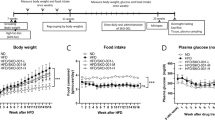Abstract
Beneficial effects of dietary phytic acid (myo-inositol hexaphosphate; IP6) have often been explained by its strong iron ion-chelating ability, which possibly suppresses iron ion-induced oxidative damage in the gastrointestinal tract. Because phytic acid is hydrolyzed during digestion, this work aimed to know whether its hydrolysis products (IP2′ IP3′, IP4′ and IP5) could still prevent iron ion-induced lipid peroxidation. Studies using liposomal membranes demonstrated that hydrolysis products containing three or more phosphate groups are able to inhibit iron ion-induced lipid peroxidation although their effectiveness decreased with dephosphorylation. Similarly, they also prevented iron ion-induced decomposition of phosphatidylcholine hydroperoxide. These results demonstrate that intermediate products of phytic acid hydrolysis still possess iron ion-chelating ability, and thus they can probably prevent iron ion-induced lipid peroxidation in biological systems.
Similar content being viewed by others
Abbreviations
- Desferal:
-
Desferrioxamine B methanesulfonate
- EYPC:
-
egg yolk phosphatidylcholine
- HPLC:
-
high-performance liquid chromatography
- IP6′ :
-
myo-inositol hexakisphosphate
- IP5′ :
-
myo-inositol pentakisphosphate
- IP4′ :
-
myo-inositol tetrakisphosphate
- IP3′ :
-
myo-inositol trisphosphate
- IP2′ :
-
myo-inositol bisphosphate
- PC-OOH:
-
phosphatidylcholine hydroperoxides
- TBARS:
-
thiobarbituric acid-reactive substances
References
Graf, E., and Empson, K.L. (1987) Phytic Acid. A Natural Antioxidant, J. Biol. Chem. 262, 11647–11650.
Graf, E., Mahoney, J.R., Bryant, R.G., and Eaton, J.W. (1990) Iron-Catalyzed Hydroxyl Radical Formation: Stringent Requirements for Free Iron Coordination Site, J. Biol. Chem. 256, 3620–3624.
Graf, E., and Eaton, J.W. (1990) Antioxidant Functions of Phytic Acid, Free Radical Biol. Med. 8, 61–69.
Halliwell B., and Gutteridge, J.M.C. (1990) Role of Free Radicals and Catalytic Metal Ions in Human Disease: An Overview, Methods Enzymol. 186, 1–85.
Babbs, C.F. (1990) Free Radical and the Ethiology of Colon Cancer, Free Radical Biol. Med. 8, 191–200.
Younes, M., Trepkau, H.D., and Siegers, C.P. (1990) Enhancement by Dietary Iron of Lipid Peroxidation in Mouse Colon, Res. Commun. Chem. Path. Pharm. 70, 349–354.
Nelson, R.L. (1992) Dietary Iron and Colorectal Cancer Risk, Free Radical Biol. Med. 12, 161–168.
Graf, E., and Eaton, J.W. (1993) Suppression of Colonic Cancer by Dietary Phytic Acid, Nutr. Cancer 19, 11–19
Sandberg, A.-S., and Andersson, H. (1988) Effect of Dietary Phytase on the Digestion of Phytate in the Stomach and Small Intestine of Humans, J. Nutr. 118, 469–473.
Iqbal, T.H., Lewis, K.O., and Cooper, B.T. (1994) Phytase Activity in the Human and Rat Small Intestine, Gut 35, 1233–1236.
Shinoda, S., Kuwata, G., Iwatsuki, S., Imai, M., and Arai, S. (1995) Effect of Inositol Phosphates (products from phytate) on Mineral Availability in Rats. J. Jpn. Soc. Nutr. Food Sci. 48, 371–378.
Baba, Y., Yoza, N., and Ohashi, S. (1985) Effect of Column Temperature on High-Performance Liquid Chromatographic Behaviour of Inorganic Polyphosphartes. Isocratic Ion-Exchange Chromatography, J. Chromatogr. 348, 27–37.
Arai, H., Mohri, S., Suzuki, T., Takama, K., and Terao, J. (1997) Coulometric Electrochemical Detection of Phospholipid Hydroperoxides by High-Performance Liquid Chromatography, Biosci. Biotech. Biochem. 61, 191–193.
Terao, J., Nagao, A., Park, D.-K., and Boey, P.L. (1992) Lipid Hydroperoxide Assay for Antioxidative Activity of Carotenoids, Methods Enzymol. 213, 454–460.
Terao, J., Piskula, M., and Yao, Q. (1994) Protective Effect of Epicatechin, Epicatechin Gallate, and Quercetin on Lipid Peroxidation in Phospholipid Bilayers, Arch. Biochem. Biophys. 308, 278–284.
Uchiyama, M., and Mihara, M. (1978) Determination of Malon-aldehyde Precursor in Tissues by Thiobarbituric Acid Test, Anal. Biochem. 86, 271–278.
Hawkins, P.T., Poyner, D.R., Jackson, T.R., Letcher, A.J., Lander, D.A., and Irvine, R.F. (1993) Inhibition of Iron-Catalyzed Hydroxyl Radical Formation by Inositol Polyphosphates: A Possible Physiological Function for Myo-Inositol Hexakisphosphate, Biochem. J. 294, 929–934.
Phylippy, B.Q., and Graf, E. (1997) Antioxidant Functions of Inositol 1,2,3-Trisphosphate and Inositol 1,2,3,6-Tetrakisphosphate, Free Radical Biol. Med. 22, 939–946.
Author information
Authors and Affiliations
About this article
Cite this article
Miyamoto, S., Kuwata, G., Imai, M. et al. Protective effect of phytic acid hydrolysis products on iron-induced lipid peroxidation of liposomal membranes. Lipids 35, 1411–1414 (2000). https://doi.org/10.1007/s11745-000-0659-y
Received:
Revised:
Accepted:
Issue Date:
DOI: https://doi.org/10.1007/s11745-000-0659-y




